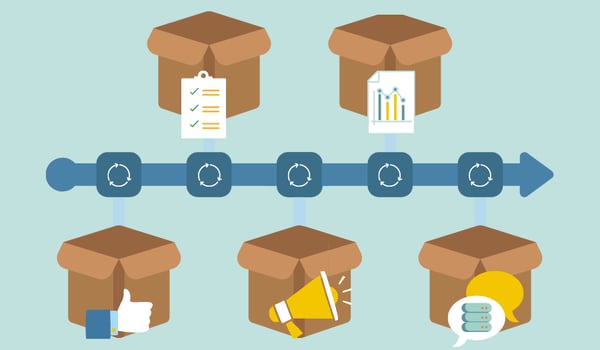KPI Metrics Every Retail Manager Should Track

Clement
Publié le 04.07.19
Mis à jour le 13.01.26
5 min
Résumer cet article avec :

Becoming data-driven is a goal that virtually all retail companies are striving for in the modern era. And, given the competitive nature of the ecosystem today, they aren't left with much of a choice. Any successful data project, perhaps especially so in a retail setting, requires business stakeholders defining and leveraging Key Performance Indicators (KPIs).
KPIs, in the retail context, are performance measures that effectively monitor retail processes. Data-driven retailer managers keep track of these measures and leverage them to optimize their processes (and profits) by doing things like more effectively identifying consumer habits, potential barriers during the purchasing process, and things of this nature.
The retail industry is unique in the sheer volume of data that can be produced, so its important that the KPIs retail managers track help them make sense of the abundance of information that's at their disposal. Tracking the “right” measures depends largely on context: your sales structure, target market, company, and so on.
All this said, the 9 KPIs listed below are highly important, and almost universally relevant, for all retail managers to consider.
What Are the 9 KPIs Every Retail Manager Should Track?
RETAIL SALES KPIS & ANALYTICS
KPI tracking linked to sales activities helps to increase the performance of your store. The predictive nature of these metrics over time also empowers retail managers to predict future sales performance and be proactive in identifying trends.
Furthermore, allowing intuitive access to this data allows retail managers to better analyze consumer behaviors and communicate relevant insights to other departments (marketing, visual merchandising, etc.)
.png?width=600&name=Capture-d%E2%80%99e%CC%81cran-2019-07-04-a%CC%80-17.13.08%20(1).png)
- Sales by Department or Category
A comparative sales volume dashboard by department or category can be a beneficial tool for retailers with a diverse offering of products and product categories. Communicated to the merchandising department, this data is valuable for:
- Product strategy
- Shelving organization
- Product promotion
For example, the manager of a sportswear store analyzes the sales levels of the sneakers. If they represent the majority of global sales, merchandising decision-makers will be able to reorganize the space to place these items at the entrance of the store – and thus obtain a good transformation rate paired with increased customer satisfaction.
- Average Purchase Value
This KPI measures the average value of each purchase made by customers. Integrating this measure allows retail managers to easily analyze historical trends, better forecast, and take steps to increase the average purchase value of each sale.
Thanks to data storytelling and guided analytics, retailers can now make KPIs like this actionable, impact their evolution, and better segment customers.
- Amount of Sales Reduced or Promoted
This KPI is an excellent tool to measure the effectiveness of promotional campaigns. As a store manager, this measure allows you to identify and report on customer spending behavior. In addition, reviewing this type of data is essential to effectively contrasting the locations of promotional items. A very useful measure to improve merchandising and, subsequently, sales performance.
INVENTORY ANALYTICS
.png?width=600&name=DOMO%20Testimonial%20%20(6).png)
Optimizing inventory management is a foundational component of success for retail businesses today. If you show us a location that lacks a strong inventory management processes, we'd expect to see a struggling business. Strong inventory analytics equip managers with the ability to easily track product status', optimize storage capacity and inventory levels, and save on the litany of associated costs that come with that (ownership costs, product depreciation etc.). In addition, savings can also be made by reducing time that would otherwise be spent on manual, or sub-optimal, inventory management.
Yet, because of the sheer volume of information that there is to be analyzed, inventory optimization is no easy task. How much of each item is in stock? What should we order again? When should we order it? Do we order too much or too little inventory? What are our best-selling and worst-selling items? How does seasonality impact this?
Data storytelling software and guided analytics best practices can equip retailers with all they need to optimize their inventory management at a glance. It is indeed possible to incorporate figures easily and to obtain visualizations that can be understood by everyone. There is no need to make calculations and the data are updated automatically. All in a single app!
Here are some inventory-related KPIs that you could track from your dashboards that will likely prove useful:
- Inventory Turnover
The inventory turnover rate is used to determine the number of times your entire inventory has been used up over a given period of time.
If you have a high turnover rate:
- Your store is performing well
- Your sales teams sell high rates of goods
- You don't have excessive inventory
If you have a low turnover rate:
- You likely have difficulty translating stock into revenue/profit
- You likely have bottlenecks at one or several places in your supply chain
Inventory turnover is an excellent metric to share with retail managers and decision-makers. This data helps in a number of ways, whether it's determining how to manipulate inventory, complimenting efficient teams, or something in between.
- Gross Margin Return on Investment (GMROI)
Gross Margin Return on Investment is an essential KPI to track because it is an effective way to evaluate the funds invested in product/inventory. In short, it evaluates how many dollars your company has been able to recover.
As a retail manager, tracking this KPI provides a more accurate picture of inventory profitability in a way that can inform future strategy; this is the most appropriate way to make better decisions about which products to store or which items to no longer store.
- Product Performance

The name itself is a good indicator of how important this KPI is. How fast are products selling? Which products are making the most money? These are some of the questions that can be answered by tracking product performance.
Product performance is based on the number of units sold over a given period, resulting in an understanding of the best (and worst) selling items for that given period. Understanding how different products perform dictates a number of important things including: investment strategy, re-order points, customer trends/forecasting.
CUSTOMER ENGAGEMENT ANALYTICS
Good retail managers frequently ask themselves, in one way or another, some of the following questions:
- How many customers can we expect in our stores?
- How long will they stay?
- Which way will they go?
- Which products are they most interested in?
- Will they make a purchase?
- How much will they spend?
The answers to these questions all lie in the data, the trick is in surfacing the insights in actionable ways. So it becomes the lack of sufficient resources (or tools) and the sheer volume of data that is the problem. What information should be prioritized? How should it be communicated to the entire company? How often?
Here are some essential measures that can be aggregated in a data storytelling application to organize and facilitate the communication of data related to purchasing behavior in stores.
- Foot Traffic
Foot traffic refers to the number of people entering a given location, often measured using people counters and retail sales analysis software.
This KPI can influence a number of important management decisions, such as staffing, order fulfillment, and more.
In addition to serving in-store managers, the efficient tracking of this KPI is very useful throughout the company. For example, foot traffic allows marketing teams to evaluate the success of specific campaigns (let's say, Black Friday Sales!), merchandisers to see how customers resonate with window display designs, and executives to dictate investment and geo-location strategies.
- Conversion Rate
The conversion rate refers to the percentage of conversions made possible based on the total number of visitors.
A conversion can be:
- A purchase
- Registration to a loyalty program
- The purchase of a product on promotion
For retail managers, monitoring this KPI is essential to measuring effectiveness. From a comparative perspective (between several stores in a given region, for example), measuring this data makes it possible to create best practices and standardize them across a store network (where appropriate, of course).
- Customer Retention
Customer retention measures the rate at which customers return to your store. This measure is an excellent indicator of customer experience, your offer's diversity, and your products' performance.
Communicating this information to your stakeholders will allow your company to develop marketing and event offers at strategic times.
This KPI can also help improve loyalty programs.
Toucan: a GUIDED ANALYTICS Solution that allows retail managers to easily track and communicate theIR MOST IMPORTANT KPIs
Retail managers that effectively track their KPIs are positioned to make a tremendous impact on the success of their businesses. Performance-obsessed retailers who want to deliver key insights, in real-time, are leveraging Toucan to easily mix multiple data sources and deploy impactful data visualizations that frontline employees understand and actually use. The platform is effective because its built to drive understanding for business users, not data scientists!
Toucan is a customer-facing analytics platform that empowers companies to drive engagement with data storytelling. Ranked the #1 easiest to use analytics solution on G2 Crowd, their no-code, cloud-based platform cuts custom development costs with a quick and easy implementation, even for non-technical builders. To find out what our users say, read their reviews on G2 Crowd.

Clement
Clément is Head of Sales at Toucan, the leading embedded analytics platform designed to help SaaS companies deliver powerful, user-friendly data experiences. With a strong background in B2B sales and customer success, he helps organizations unlock the full value of their data by embedding intuitive dashboards directly into their products. On Toucan’s blog, Clément shares insights on how embedded analytics can drive customer engagement, boost retention, and create new revenue streams for SaaS businesses. His expertise lies in bridging the gap between business needs and data solutions to help companies scale smarter.
Voir tous les articles

.png?width=600&name=Capture-d%E2%80%99e%CC%81cran-2019-07-04-a%CC%80-17.03.15%20(1).png)
